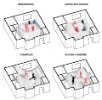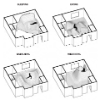Domesticity and Mass Customization

Rendering of user and holograms within (SACoP).
The Situated Technologies studio of the Spring 2020 semester focused heavily on ideas of domesticity and “mass-customization” in their design investigations. Mass-customization is a term used to describe a change in business perception from a mass market to a mass-customized market. Products developed within a mass-customized market are often altered to fit an individual customer’s needs, leading to more effort placed into manufacturing and retail methods.
Gallery
Students
Xuwen Zhang, Rossella GiangrecoMarotta, Anna Mytcul, Jenifer Persico, Leah Carptenter
Faculty
Omar Khan
Term
ARC 603
Spring 2020
Program
MArch
Students within this graduate research group worked both in groups and individually to develop research topics that interested them within the category of mass-customization. They explored different aspects and phases of the housing industry to understand the impacts of the potential future of mass-customization on concepts of domesticity in the architectural realm.
Students explored ideas of life-cycle costs, construction processes, occupancy, and demolition to evaluate the impacts mass-customization has on waste production, affordability, and new definitions of architectural technologies. They worked to examine ideas of rental spaces becoming more inclusive to residents through the modularity that this design method has to offer, making these spaces feel more permanent.
Students investigated the effects of mass-customization on trends of urbanization and suburbanization. These investigations showed that urbanization lacks affordable housing and could benefit from the use of prefabricated materials, and suburbanization offers affordability but at the price of customization and individuality.
Investigations of affordability were conducted within the studio as well, evaluating the differences between mass-customized homes. Students identified the advantages of pre-fabricated housing to be: speed, sustainability, safety, incorporating technology (both within the home and building process), cleanliness, quality and value. Students also examined methods of construction, including panelized wood framing, sandwich paneling, steel framing, timber framing, concrete systems, and modular systems.
Groups looked into subcategories of mass-customization involving waste management, affordability, modularity, resilience and organization strategies for climate change, biotechnics, housing types, behavior, material exchange, home energy outputs, building and occupant lifestyle changes, community outreach and impact, food securities, livelihood, and enclosure. Students developed their work by following an outline of precedent studies and research, and created graphics that could be designed into pamphlets. This initial research was then organized to aid groups in their own investigations and interests.
Within their research Anna Mytcul examined another form of domesticity with a project titled “System of Affective Co-Presence (SACoP).” Mytcul explored existing research that used artificial technology to their advantage. Within their investigations Mytcul proposed that artificial intelligence could be used to amplify leisure activities for the user and allow for these technologies to support creativity and relationships between participants. Within their design proposal artificial intelligence is used much like a memory foam mattress within the surfaces of the building to instill interaction with the human body and replace the need for furniture. Mytcul wishes to use these parameters in space to further connect people within different time zones through holograms and physical sensor inputs as well as to provide self-regulating parameters for individual use and comfort.
Leah Carpenter and Jennifer Persico proposed “The Third Skin,” a temporary shelter that the user can shape to their particular needs. An individual receives a 10x10 foot folded sheet of mycelium leather (at 4 oz per sq ft or roughly 35 lbs). The triangular pockets are hollow until brought to site where elements such as heat, oxygen and water would activate the mycelium within those pockets. Within the next four to five days the individual could shape the sheet to their preferences before the mycelium fully inhabits the pocket and becomes rigid. The inner sheet attached to the diagrid structure encases slow-growing mycelium that upon growth starts to mold the interior space.
When an individual abandons the shelter or the materials have reached their expectancy of a year, the shelter undergoes decay. The mylea leather begins to break down exposing the mycelium within to accelerate decomposition. Within a month the fully decomposable sheet has returned to the ground, feeding the other living matter.





